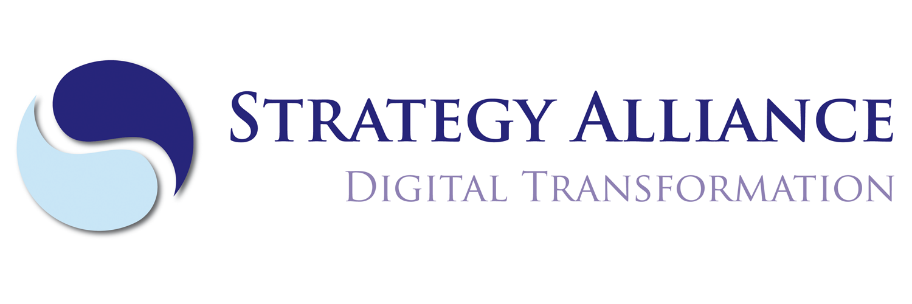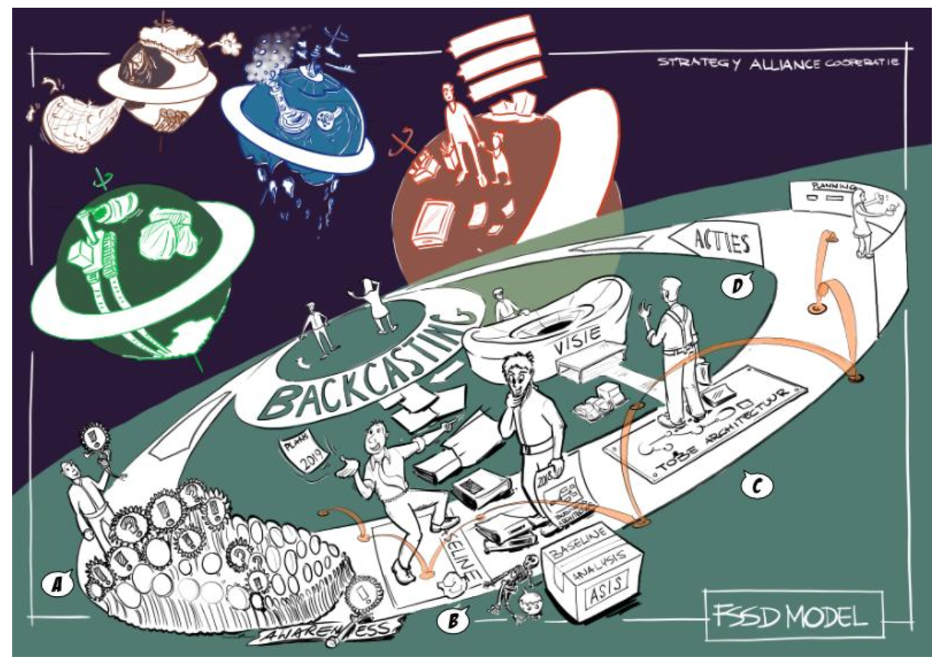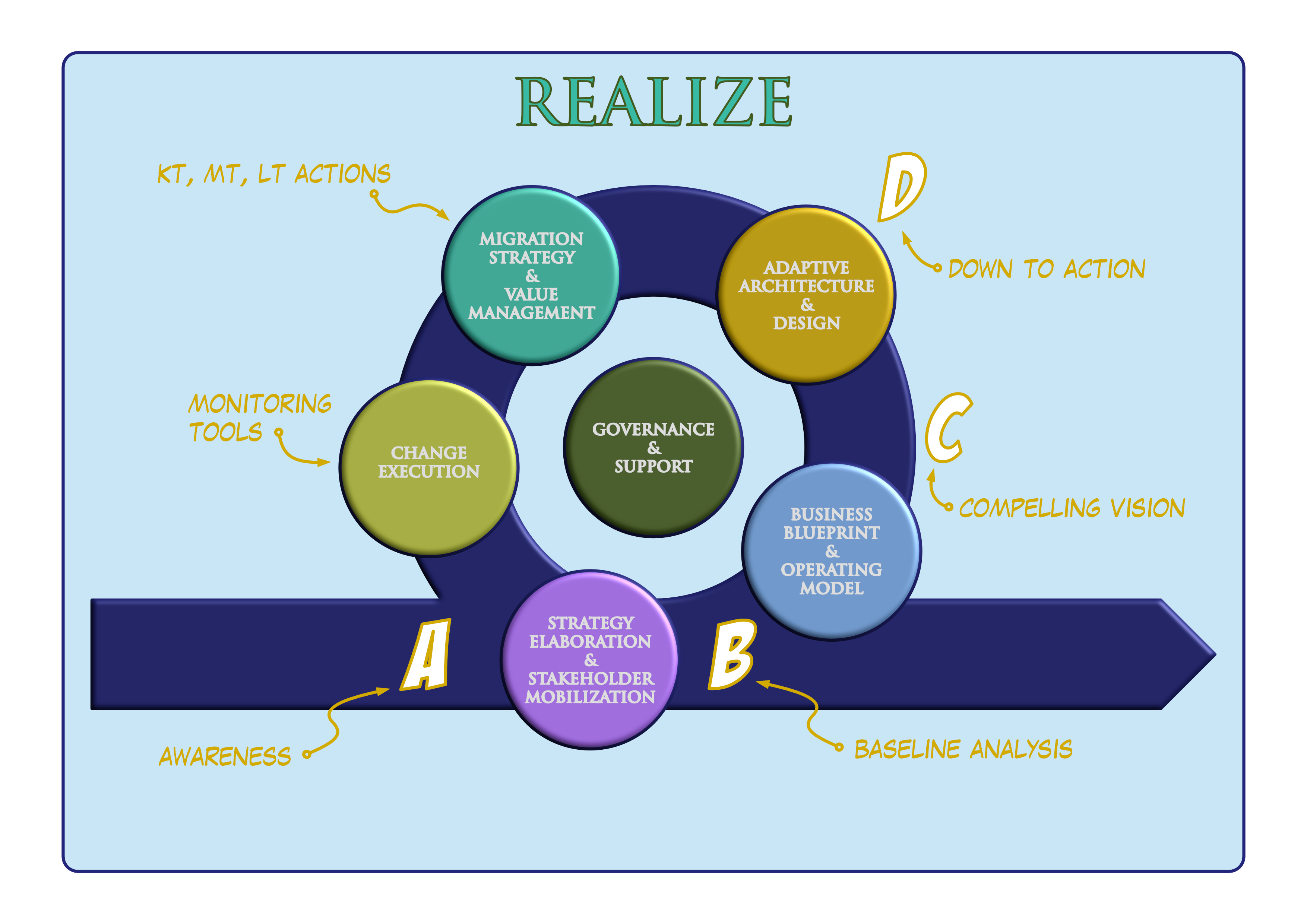Fortunately, we are smart enough to understand what the problem is, and we know what we can do about it. But we need a clear guideline, and there it is: The Framework for Strategic Sustainable Development (FSSD). In our previous blog In our earlier report we briefly mentioned the four pillars of the FSDD: Systems thinking, Basic Principles of Sustainability, the ABCD process and the 5-level model. We then zoomed in on systems thinking. Systems thinking is one of the steps needed to fix the flaws in our system. In this article we focus on the next two crucial steps: applying the four Basic Principles for Sustainability and the ABCD process, which works with Backcasting.
Strategy Alliance has put Sustainability at the centre of its value proposition! Why? Because Digital Transformations are taking place on a large scale in all organisations, the opportunity to include sustainability in this change. Just like defining your new business model, thinking about strategy and business architecture is the moment to make the choices that can have a real impact on sustainability. Therefore, sustainability needs to be incorporated into digital transformations and the entire architecture of an organization. The FSSD makes this possible, by making clear what needs to change. And the state of our technology is not the problem. All the solutions are already there.
The Four Fundamental Principles of Sustainability
When you start with a Digital Transformation, you determine what can be done better or differently now, and design your business architecture accordingly. The FSSD is the tool to do that for the Sustainability aspects, it clearly shows what the four woeful errors are that lead to systematic unsustainable behaviour, and what is therefore needed:
- Society systematically extracts and distributes raw materials from the earth's crust (e.g. fossil fuels and heavy metals) at a much higher rate than the rate at which these substances are returned to the earth's crust. So substances like CO2 accumulate, with all its consequences. So we need to get back to a level that the Earth can handle, and become largely independent of fossil fuels and mining.
- Society systematically produces more (substances foreign to nature) than nature can process in its natural cycles (e.g. dioxins, DDT and PCBs, but also nitrogen). Consequently, these (toxic) substances also accumulate and poison or eutrophy our environment. That is why zero waste systems are so important and why our emissions must become nature-friendly.
- Society is systematically depleting the Earth's ecosystems faster than they can regenerate and damaging them beyond repair (for example, through overfishing, large-scale logging, cultivation of fertile land with major infrastructure, or other forms of manipulation of ecosystems). So we undermine the Earth's ability to keep itself habitable. Sustainable use of ecosystems is therefore crucial, both on land and in the oceans.
- We subject people to circumstances that systematically undermine their ability to meet their basic needs (e.g. through exploitation, exclusion and oppression). FSDD's basic human needs are: health, influence, competence, meaning and fair treatment. If these needs are not met, people become unhappy and sick. Communities fall apart and people start displaying increasingly unsustainable and unhealthy short-term behaviour. We can prevent this by actively combating inequality, exploitation, exclusion and oppression.
These four woeful errors and basic principles are found in the illustration below as the planets we must keep a close eye on to navigate toward a sustainable system. They are the landmark for Backcasting and the ABCD process.
Backcasting and the ABCD process
Backcasting and the ABCD process are the third pillar of the FSSD. From a vision of the future, based on the four basic principles, we reason back to the current situation. This method provides tools for a long-term vision and facilitates step-by-step innovation within an organisation. The power of Backcasting is that it stimulates out-of-the-box thinking and anticipating future (unknown) situations. The ABCD process works with, you guessed it, four steps:
- Awareness. Awareness and forming an image of what the future of the organization looks like when the sustainability principles are applied. This image is created by looking ahead for a long period of time and letting go of all restrictions, such as regulations and technical barriers.
- Baseline analysis. Current reality: using the sustainability principles to provide insight into the organization's current situation.
- Compelling vision. By reasoning from the future image (A) back to the current situation (B), creative solutions and actions emerge with which the difference can be bridged. These form the basis for a vision of the future organization that is based on what is desirable, taking into account - but not limited by - the current situation.
- Decide on priorities and Down to action. Decide on priorities: the solutions are incorporated into a sustainability strategy with action points for the short, medium and long term.
In addition to the four basic principles for designing a sustainable organisation, the FSSD has four other principles of a different order, which are of great importance throughout the process. These are transparency, inclusiveness, accountability and fairness. This refers to involving stakeholders in the dialogue on sustainability and communicating openly and honestly about an organization's ambitions, progress and dilemmas.



